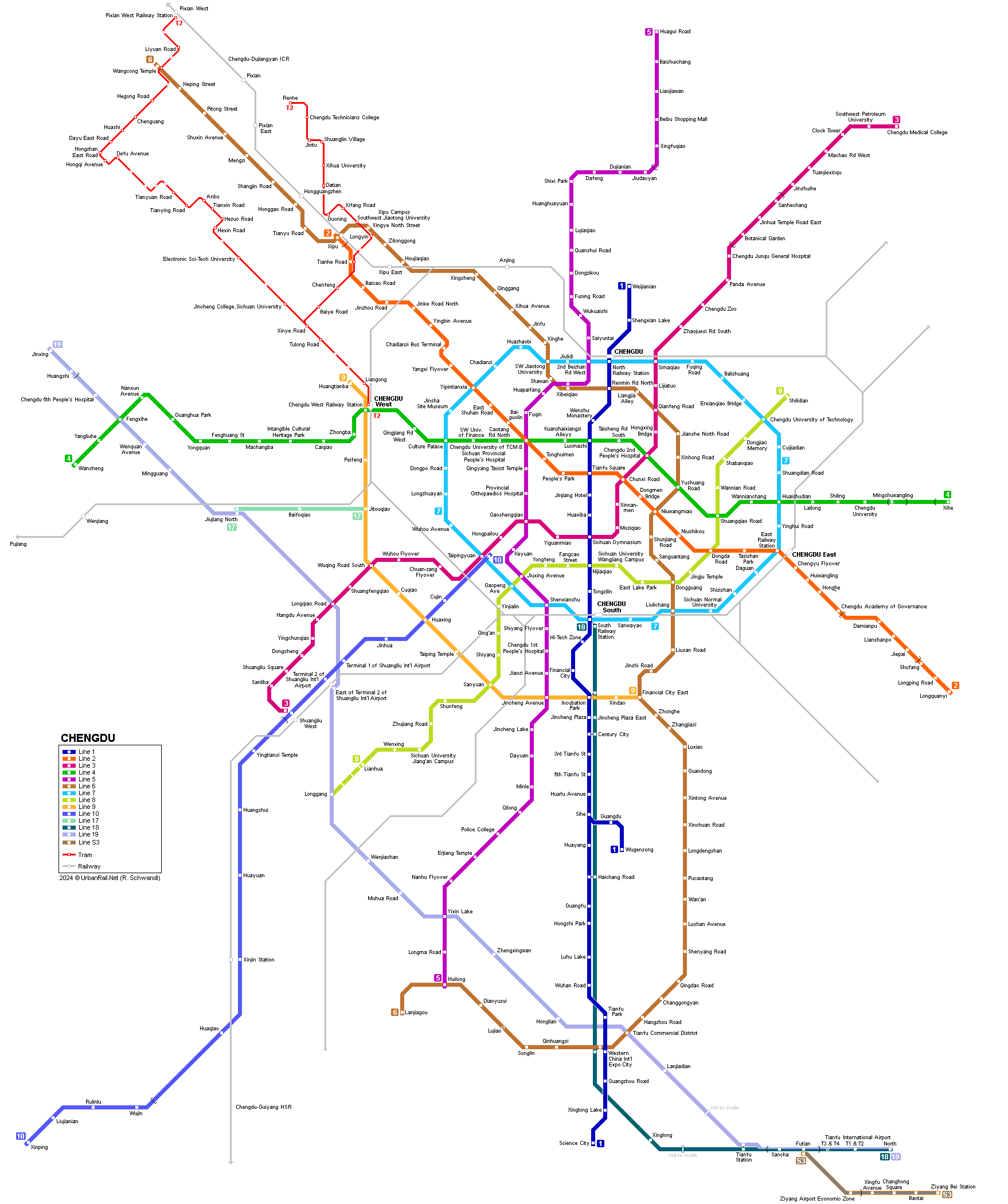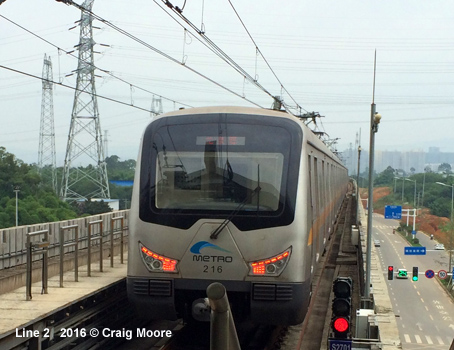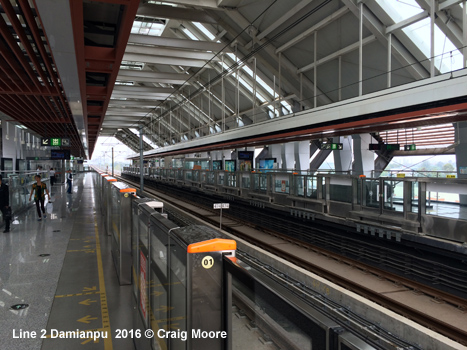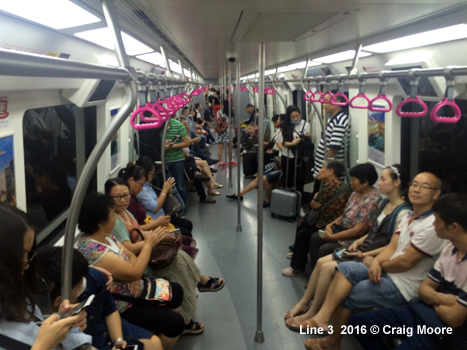
|
[ UrbanRail.Net ] [ Europe ] [ Americas ] [ Asia ] [ Africa ] [ Oceania ] [ News ] [ Books ] [ Links ] |
|
CHENGDU
|
| China |

|
System
|
|
Chengdu, the capital of the Sichuan province, has some 3 million inhabitantas, with some 16 million inhabitants in the metropolitan area. It is located in southwestern China, west of Chongqing. After construction had begun in 2005, phase 1 of line 1 started limited service in Sept 2010. By 2020, the overall network length had already surpassed 500 km.
|


 |
|
Lines
|
| ..... |
| Line 1 |
|
- 40.9 km, 35 stations 27 Sept
2010: Shengxian Lake - Century City (18.5 km, 16 stations)
|
|
|
| Line 2 |
|
- 42.2 km, 32 stations 16
Sept 2012: Chadianzi Bus Terminal - Chengdu Institute of Public Administration
(22.4 km)
|
|
|
| Line 3 |
|
- 50.5 km 31 July
2016: Taipingyuan - Chengdu Junqu General Hospital (20.4 km, 17
stations)
|
|
|
| Line 4 |
|
- 43.1 km, 30 stations 26
Dec 2015: Intangible Cultural Heritage Park - Wannianchang (22.1
km)
|
|
|
| Line 5 |
|
- 49 km, 41 stations 27
Dec 2019: Huagui Road - Huilong (49 km)
|
|
|
| Line 6 |
|
- 69.7 km, 56 stations 18
Dec 2020: Wangcong Temple - Lanjiagou (69.7 km)
|
|
|
| Line 7 |
|
- circular line 38.6 km long with 31 stations 06 Dec 2017: Chengdu North Railway Station - Chengdu East Railway Station - Chengdu South Railway Station - Culture Palace
|
|
|
| Line 8 |
|
- southwest-northeast line:
18 Dec 2020: Lianhua - Shilidian (28.8 km)
|
|
|
| Line 9 |
|
- tangential line, 21.8 km long with 13 stations 18 Dec 2020: Huangtianba - Financial City East (21.8 km)
|
|
|
| Line 10 |
|
- 37.9 km, 16 stations
06 Sept 2017: Taipingyuan - Shuangliu Int’l Airport Terminal 2 (10.9
km)
|
|
|
| Line 17 |
|
18
Dec 2020: Jitouqiao - Jinxing (25.3 km; including Jinxing -
Jiujiang North section of the future line 19)
|
|
|
| Line 18 |
|
- 67.9 km express line to Tianfu Airport 27
Sept 2020: South Railway Station - Sancha (48.2 km)
|
|
|
| Line 19 |
|
- 63 km (Jinxing - Tianfu Station) + through operation with line 18 to Tianfu International Airport North 18
Dec 2020: Jitouqiao - Jinxing (25.3 km - future line 19 operated
as part of line 17)
|
|
|
| Line 27 |
|
19 Dec 2024: Shifo – Shuxin Road (24.9 km)
|
|
|
| Line S3 |
|
29 Sept 2024: Futian – Ziyang Bei Station (38.7 km)
|
|
|
|
Chengdu Tram |
|
The initial section of a tram system in the northwestern suburbs of Chengdu opened in late 2018; expanded to full size in Dec 2019: 39 km 26
Dec 2018: T2 Chenguang – Hexin Road
(13.5
km)
|
|
|
|
Metro Projects |
|
See Chengdu Metro at Wikipedia!
|
|
Photos
|
|
..
|
|
Links
|
|
Chengdu Metro (Official Website) Chengdu Metro at Wikipedia
|
|
Report
|
|
In March 2018 (updated in Aug 2019), Craig Moore reports from Chengdu: The Chengdu Metro began operations in 2010 and has witnessed incremental growth, with expansion of the system occurring in every subsequent year with the exception of 2011. This growth pattern makes the Chengdu Metro a very useful illustration of the underlying trends in Metro development in China, where clear differences in style are evident between earlier and later lines/extensions. The system is now 223.1km (revenue Km) (208km underground) with 153 stations, making it the 7th longest in China and 16th longest in the world (Sep19). It has six lines - structured as a north-south (L1/3) and north-west to south-east (L2/4) system, together with a strategically important Ring Line (L7) and a south westerly appendage (L10) to the airport. Chronologically and stylistically, the lines can be divided into three groups: Lines 1 and 2 were opened between 2010-2012, although there have been subsequent extensions. These lines use CSR stock in 6-car sets and are the busiest lines on the system. Line 1 (39.9km) is the original line and the early sections look quite dated with rather similar station form in that they follow the blueprint for Chinese Metro construction used at that time – basic angled street entrances (except the large, stunning, circular Tianfu Square), standard format ticket halls with ticket machines (fares are distance-based across the system at 2-9 Yuan), security, barriers and customer support. Central escalators and stairs lead to island platforms with full platform screens, RTI, basic furnishings, and solid information provision. The line operates 5min base headways and connects many of the main trip-generating points in the city such as North and South Railway Stations, the new southern commercial area around Century City and Tianfu Square, the main transfer station of with its island/two side platform layout for access/exit at either side of the train. There are variances though, with central stations having some distinguished design elements on station pillars and the lengthy southern extension to the Technology Zone (opened on 17 Mar 18) show a significant leap forward in station design and style (as per Line 7 below) with highlights being Hongshi Park and Guangzhou Road. This section includes a branch to Wugensong and the connecting station Sihe being a four line/2 island station. Each branch carries a 5min headway making a 2/3min frequency on the long stretch north – and this frequency is required as it is a very busy line. Accompanying the new extension is new stock with dynamic strip maps. For most of its length, Line 2 has a similar feel to Line 1 but being a longer line (41.5km/33.7km underground) and having extensions in 2013 (west) and 2014 (east), it does offer some differences. There is cross-platform transfer at East station with Line 7 and further southeast at CIPA, alternate trains from the west terminate, providing 10min headways on to Longquanyi. This section beyond CIPA also has a lengthy elevated section around Lianshanpo - the elevated stations having side platforms with half screens and being quite unstylish and frayed. To the north and west, Line 2 also has two cross-platform interchanges – at CUTCM where Line 2 intersects with Line 4, and at the elevated terminus station of Xipu, a large station with 2 island platforms to allow for cross-platform interchange (barriered) with regional CRH services to/from Dujiangyan, the metro service using the central lines between the two platforms. Services operate 5 to 6min base headways and journey time on Line 2 is 1h12mins. Lines 3 and 4 have quite a different feel from the original lines as they were brought into operation from late 2015 to mid-2016. Many of the underground stations appear to have a slightly smaller footprint than Line 1 and 2, with smaller ticketing areas and narrower island platforms. The lines operate the same 5/6min headway but utilise CNR stock which has more advanced above-door information. Although island platforms and full screens dominate, these lines have more stylish platform areas than the earlier structures. Line 3 is the longest line on the system and runs mostly underground in a southwest-northeast alignment (49.6km/44.1km UG). Its route visits Chengdu’s Central Business District to the east of Tianfu Square and the Shuangliu area in the south-west. At Taipingyuan there is a broad and artistically beautiful cross platform transfer to Line 10 and most stations have interesting themed displays on pillars and walls, and have differentiated ceilings designs. The three-station elevated section in the north east offers some great views and the stations have high arched roofs with glass panels, admitting much light on the smart island platforms. Line 4 (43.0km/41.4km UG) follows an east-west direction on its 1h08 journey. It serves the busy West Railway Station and several visitor sites such as Sichuan Museum and Intangible Cultural Heritage Park. Stations have elements of design style and individuality at both ticket hall and platform levels and in the east the line has two short elevated sections around Mingshuwangling. The stations here have modern, bright ground level entrances with central stairs/escalators up to the side platforms. These have half screens and are topped by high arched roofs. The route here shows some interesting views of the eastern suburbs of the city. Line 7 and 10 - The newest lines on the system offer some good examples of the confidence Chinese metro design has today, with bold interpretations on traditional styles and a creative use of imagery. Unlike the B type stock used on the other lines, these use A type CRRC 6 car stock with dynamic strip maps which show travel times between stations, flashing rings to illustrate the number of minutes to the next stop and platform arrival information which illuminates your carriage and where stairs/lifts or transfer access is located – very impressive. The stock also has wood veneer panelling at the end of each carriage and at the drivers cab. Line 7 is a 39.1km fully underground ring line (1h07) operating as ‘outer’ and ‘inner’ (clockwise) services at 5/6min base headways, with the terminus displayed as Cuijiadian (depot is located here). The line visits several of the city’s education establishments and important long distance rail hubs. It also offers easy transfer to the networks cross-city lines at 8 stations, where Line 7 has the deeper alignment. Although all stations have island platforms, many have unique and impressive design characteristics including long locally related art panels at entrance level and pillars/ceilings with themed designs at platform level. These attributes bring different colour and ambiance (particular colours dominate depending on which part of the ring you are on, these related to north, south, east and west) along the line as it progresses around the city (Taipingyuan, Simaqiao, Jinsha Site Museum, North and East stations stand out). The flair of Line 7 has not fully transferred to Line 10 even though they opened within three months of each other in late 2017. This line is different because it is an adjunct to the rest of the system, it has only 8min base headways and its stations (at platform level) have seen a return to the standard island platform design, even though these are bright with a glossy sheen. At entrance hall level there are some impressive examples of imagery from local history and topography and there is a freshness to the stations. The 6 car stock is also distinctive in that it has predominantly paired seating with only occasional lateral rows, these having a beige, school canteen type appearance. There is also wood veneer coverings at the ends of carriages giving the interiors a quite dated look, despite the high quality dynamic electronic information present. At the airport, the stations are centrally located and well signed within the terminals - unlike at some airports, you soon find yourself in the metro station. The 10km fully underground line takes only 13mins to reach Taipingyuan where simple cross platform transfer to Line 3 enables passengers to reach the centre of town within a total of 25mins (a far cry than the slow airport buses). The metro’s presence in the city is impressive with entrances and tall angled totems easily recognisable and, being a well-spaced system in the centre, you are never far away from a metro station. Services operate from approx. 0615-2300 with all lines well used, service frequencies good and fast, smooth running across the system. Stock is colour-coded with handles, bars and exterior coloured bands below the windows related to the specific line colour, along with the ring-like city crest - you most definitely know which line you are on, and wayfinding is excellent as one expects in China (all signage, and electronic and audio information is in Mandarin and English). There is easy/short transfer at interchange stations, which again are well dispersed across the city centre/inner south and at main transport hubs in more peripheral areas. In terms of navigational aids, there is a schematic map at the end of each platform and on trains (these are in both small landscape and larger portrait format with portrait offering a more realistic representation of the system and showing the tram route). Summer 2019 also brought a new bi-lingual schematic map leaflet which is available at most stations. Line 10 also has a smashing system map (Chinese/Latin alphabet) with illustrations of tourist sites. CRTG also operates a new tram. Tram systems being part of the overall urban rail system (ownership/operations) is quite rare in China (Beijing being the only other example I can think of) and the T2 line is situated on all Metro maps and will eventually be physically and functionally integrated into the Metro network (L2/L4) once the extensions are completed. The line runs in the north west between Chenguang and Hexin Road (13·6km) with 16 smart but basic halts. The CRRC Changchun pale aqua articulated units (similar in appearance to the Alstom Citadis) are smart and the route runs mainly in the centre of broad avenues in a newly developing part of the city. Services have 10min base headways and current patronage levels are quite low, although once the area reaches development and there is physical connection to the Metro, it is envisaged that patronage will be high. In summary, from pretty unexceptional beginnings, this system has grown and matured into a fine metro specimen – it has great coverage, fantastic station designs, great service levels and an excellent soft offer. Certainly this is now one of the best in China..
|
2007 © Robert Schwandl (UrbanRail.Net)